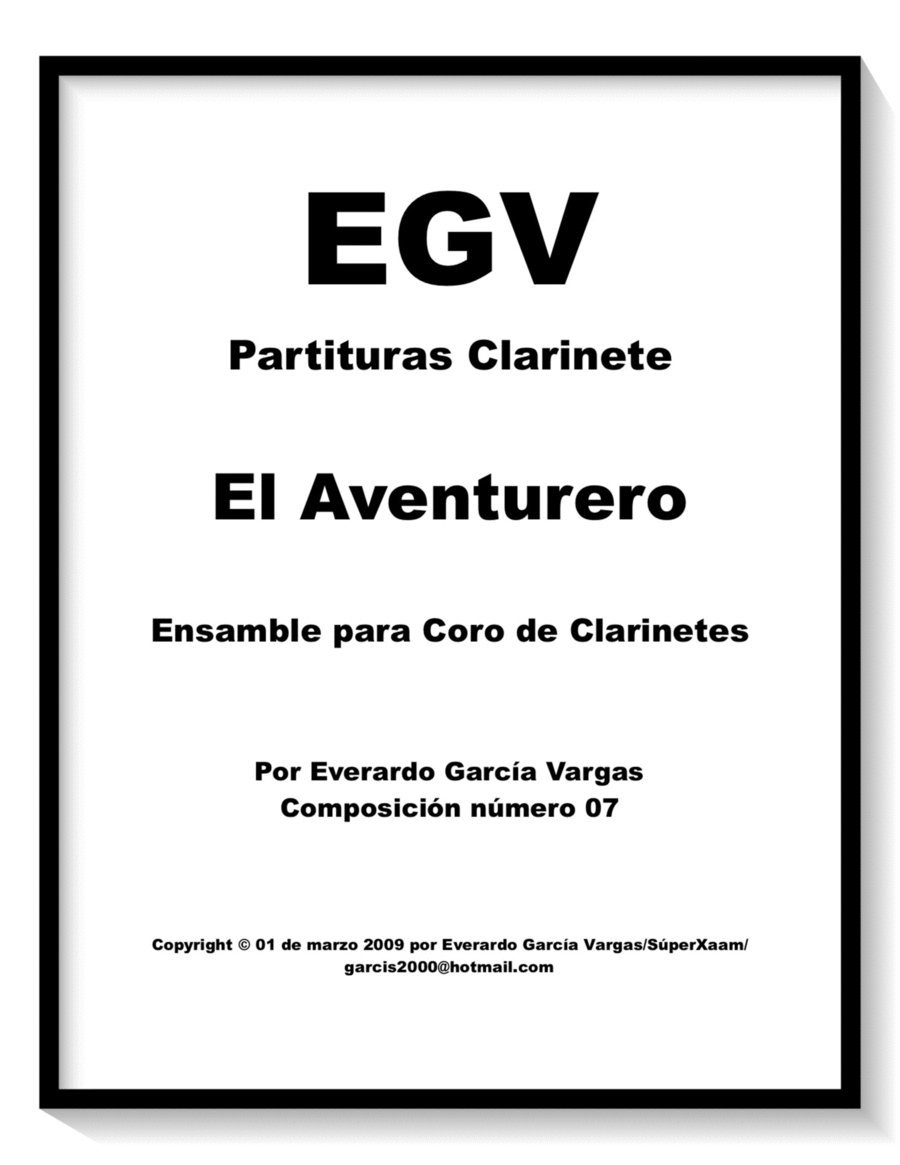Clarinet Choir,Woodwind Ensemble Bass Clarinet,E-Flat Clarinet - Level 4 - Digital Download SKU: A0.1240964 Composed by Everardo GarcÃa Vargas. Chamber,Classical,Holiday,Multicultural,Traditional,World. 62 pages. Everardo GarcÃa Vargas #836358. Published by Everardo GarcÃa Vargas (A0.1240964). El Aventurero - Ensamble para Coro de ClarinetesEn abril de 2022, se lanzó esta nueva versión oficial definitiva de la composición Nº 07 âEl Aventureroâ, un ensamble para coro de clarinetes. Esta actualización fue posible gracias a la valiosa retroalimentación proporcionada por maestros, compañeros, alumnos y público en general, quienes solicitaron la incorporación de nuevos temas y una mayor duración de la obra para satisfacer la demanda de una experiencia auditiva más completa. Los aspectos más destacados y significativos de esta nueva versión radica en la incorporación de nuevos temas inéditos, tales como dos estribillos, un trÃo y un montuno extendido en forma de improvisación. Este último elemento fue fundamental para desarrollar, expandir y aventurarme nuevamente en la obra. A través de él, pude plasmar los ciclos de mi vida y transportar el pasado hacia el presente. Asimismo, se incorporó un desenlace explÃcito y coherente para garantizar que el oyente comprenda de manera inequÃvoca la conclusión de la obra. Esto contrasta con la versión anterior, que dejaba cierta ambigüedad sobre si la pieza continuaba o habÃa llegado a su fin. Además de los nuevos temas, se realizaron mejoras en los ya existentes ampliando algunas frases y motivos y se añadieron puentes para facilitar la unión y repetición, y también se introdujeron cambios en los contrapuntos y armonÃas en frases especÃficas. En su obra âEl Aventureroâ, el compositor mexicano comparte su historia personal a través de las distintas etapas que ha experimentado a lo largo de su vida. Originario de la comunidad de Tlahuitoltepec Mixe, Oaxaca, el autor creció hablando la lengua mixe y se sumergió en las tradiciones, usos y costumbres de una comunidad rica en cultura. Desde temprana edad, estuvo expuesto a bandas filarmónicas con repertorios de sones y jarabes. A la edad de diez años, tuvo su primer acercamiento a la música a través de lecciones impartidas por su padre. Posteriormente, continuó su aprendizaje de manera autodidacta y se unió a la banda municipal del pueblo. Con el paso del tiempo, la banda municipal, ahora conocida como BASTLAM, alcanzó su máximo potencial en la década de los 90. Fue entonces cuando comenzaron las giras musicales y el autor tuvo la oportunidad de visitar las ciudades de Oaxaca, México y Veracruz. Quedó impresionado por la belleza de las grandes ciudades y sus distintas tradiciones, pero sobre todo por su rica cultura musical. Posteriormente, se trasladó a la Ciudad de México para residir allà temporalmente. Sus viajes musicales continuaron por casi todos los estados de la República Mexicana. Durante estos viajes, adquirió experiencias y conocimientos valiosos, maravillándose ante la magnificencia de las diferentes culturas, tradiciones y estilos musicales de cada estado. En conclusión: âEl Aventureroâ es una obra fascinante en la que el compositor mexicano relata su historia personal a través de las distintas etapas de su vida. Desde sus orÃgenes en la comunidad de Tlahuitoltepec Mixe, Oaxaca, hasta sus viajes musicales por la República Mexicana, el autor ha tenido la oportunidad de experimentar y aprender de las ricas culturas y tradiciones de su paÃs. Su pasión por la música lo ha llevado a lugares y experiencias inolvidables, y esta obra es un testimonio conmovedor de su viaje. La nueva versión de âEl Aventureroâ representa una evolución enriquecedora de la obra original. Gracias a la incorporación de nuevos temas y desarrollos que invita al oyente a sumergirse en un emocionante viaje musical. Las sugerencias y comentarios recibidos permitieron mejorar y expandir esta composición para ofrecer una experiencia única.
